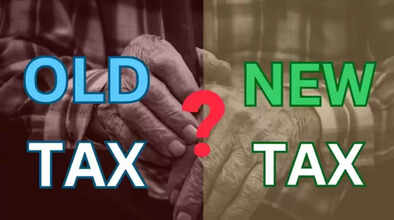Income Tax Tips: New or old income tax system, which one will be beneficial after retirement?

Income taxpayers now have the option to select one of the two types of tax regimes. Since the government has increased the limit of tax rebates from Rs 5 lakh to Rs 7 lakh in the new tax regime, it has become more attractive than before. Along with this, the benefit of a standard deduction of Rs 50 thousand has also started being available in it. But an important question is which of the two tax regimes is better for retired senior citizens.
Many people who have recently retired are confused about whether the old tax system will be better for them or the new tax system. This confusion has increased a lot due to the reduction in pension compared to salary after retirement and the increase in the limit of tax exemption under the new tax system. Here we will try to understand this issue.
Senior citizens have both options First of all, it is important to know that while filing income tax return, any taxpayer will see the new tax regime as the default option, but you can change it according to your convenience. That is, if you want to adopt the old tax regime, then you will have to select that option.
Income tax slabs according to age Under the income tax rules, people above 60 years and up to 80 years of age are considered senior citizens, while those above 80 years of age have been given the status of super senior citizens.
In the new tax regime, the income tax slabs are the same for all individual taxpayers. Whether they are citizens below 60 years of age senior citizens between 60 and 80 years of age or super senior citizens above 80 years of age. But in the old regime, there is a slight difference in the rates for senior and super senior citizens. We will look at this difference later.
Income tax slabs in the new regime
> No income tax on annual income up to Rs 3 lakh
> 5% tax on annual income of more than Rs 3 lakh and up to Rs 6 lakh
> 10% tax on annual income of more than Rs 6 lakh and up to Rs 9 lakh
> 15% tax on annual income of more than Rs 9 lakh and up to Rs 12 lakh
> 20% tax on annual income of more than Rs 12 lakh and up to Rs 15 lakh
> 30% tax on annual income of more than Rs 15 lakh
In the new tax regime, income up to Rs 7 lakh is tax-free
In the new tax regime, tax liability is created on annual income of more than Rs 3 lakh, but those with annual income up to Rs 7 lakh get the benefit of tax rebate under section 87A. That is, their tax liability is waived by giving a rebate.
Apart from this, salaried and pensioners also get a standard deduction of Rs 50,000. If we add this, then no tax has to be paid on income up to Rs 7.5 lakh. Whereas in the old tax regime, the benefit of tax rebates is available only to those with an annual income of up to Rs 5 lakh.
Old tax regime: Tax slab for senior citizens aged 60 to 80 years
> No tax on annual income up to Rs 3 lakh
> 5% on income above Rs 3 lakh and up to Rs 5 lakh
> On income above Rs 5 lakh and up to Rs 10 lakh: Rs 10,000 + 20% of income above Rs 5 lakh
> On income above Rs 10 lakh: Rs 1.10 lakh + 30% of income above Rs 10 lakh
Old tax regime: Tax slab for senior citizens aged above 80 years
> No tax on annual income up to Rs 3 lakh
> 5% on income above Rs 3 lakh and up to Rs 5 lakh
> On income above Rs 5 lakh and up to Rs 10 lakh: 20% of income above Rs 5 lakh
> On income above Rs 10 lakh: Rs 1 lakh + 30% of income above Rs 10 lakh 30%
Income up to Rs 5 lakh tax-free in old tax regime
In the old tax regime, taxpayers of any age get tax rebates on income up to Rs 5 lakh under section 87A. That is, if the taxable income is up to Rs 5 lakh, then no income tax has to be paid due to tax rebate under section 87A. We have already seen that in the new tax regime, this benefit of tax rebate is available on annual income up to Rs 7 lakh.
Follow our Whatsapp Channel for latest update

